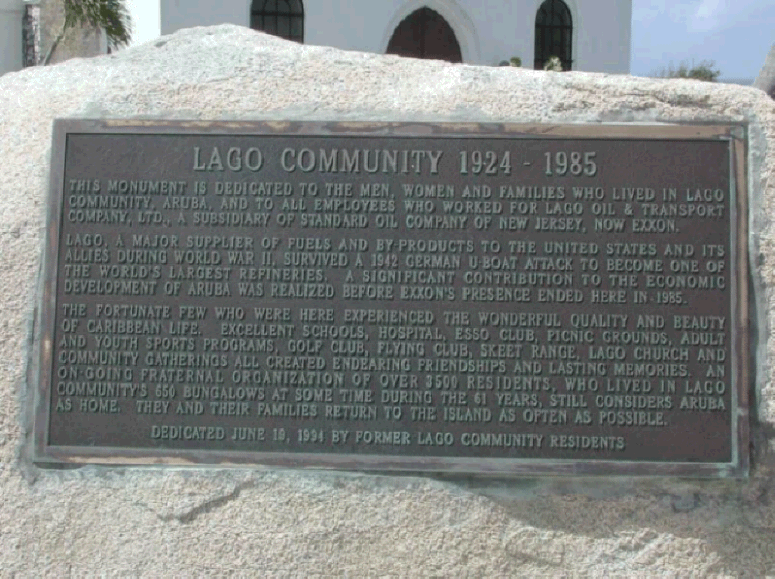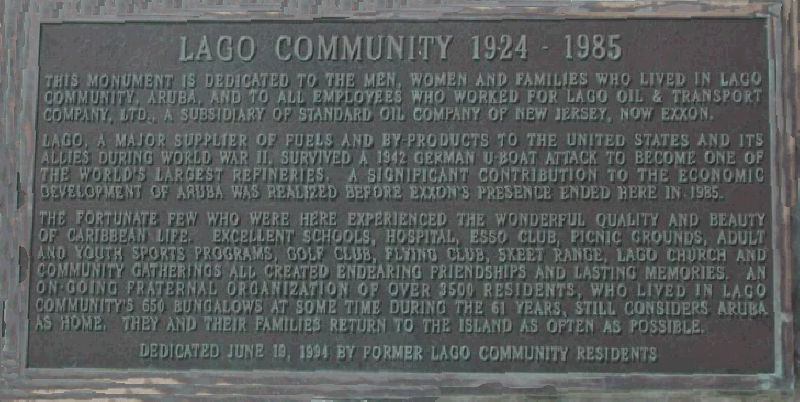THE PLAQUE AT THE COMMUNITY CHURCH


The following was sent to me by Richard Sabine on January 5, 2009.
The well maintained
church is strangely out of place amid neighboring bungalows in varying
stages of decay and disrepair. It sits silently in bright sunlight upon
the hill that suddenly rises from a sandy beach of the Caribbean. A
plaque affixed to a large stone in front of the church explains the
church’s circumstance.
LAGO COMMUNITY 1924-1985
THIS MONUMENT IS
DEDICATED TO THE MEN, WOMEN AND FAMILIES WHO LIVED IN LAGO COMMUNITY,
ARUBA AND TO ALL EMPLOYEES WHO WORKED FOR LAGO OIL & TRANSPORT COMPANY
LTD., A SUBSIDIARY OF STANDARD OIL OF NEW JERSEY, NOW EXXON.
LAGO, A MAJOR SUPPLIER OF FUELS AND BY-PRODUCTS TO THE UNITED STATES AND
ITS ALLIES DURING WORLD WAR II, SURVIVED A 1942 GERMAN U-BOAT ATTACK TO
BECOME ONE OF THE WORLD’S LARGEST REFINERIES. A SIGNIFICANT CONTRIBUTION
TO THE ECONOMIC DEVELOPMENT OF ARUBA WAS REALIZED BEFORE EXXON’S
PRESENCE ENDED HERE IN 1985.
THE FORTUNATE FEW WHO WERE HERE EXPERIENCED THE WONDERFUL QUALITY AND
BEAUTY OF CARIBBEAN LIFE. EXCELLENT SCHOOLS, HOSPITAL, ESSO CLUB, PICNIC
GROUNDS, ADULT AND YOUTH SPORTS PROGRAMS, GOLF CLUB, FLYING CLUB, SKEET
RANGE, LAGO CHURCH AND COMMUNITY GATHERING ALL CREATED ENDEARING
FRIENDSHIPS AND LASTING MEMORIES AN ON-GOING FRATERNAL ORGANIZATION OF
OVER 3500 RESIDENTS, WHO LIVED IN LAGO COMMUNITY’S 650 BUNGALOWS AT SOME
TIME DURING THE 61 YEARS, STILL CONSIDERS ARUBA AS HOME. THEY AND THEIR
FAMILIES RETURN TO THE ISLAND AS OFTEN AS POSSIBLE.
DEDICATED JUNE 19, 1994
BY FORMER LAGO RESIDENTS.
Theirs, is a story of
paradise lost, an abruptly forced relocation that separated people and
place. The Lago Colony had to be an idyllic community, a near perfect
society. The residents were homogonous; they shared the same employer,
purpose and neighborhood. Even the bungalows were egalitarian, differing
mainly in the number of bedrooms and placement within the community.
There was no poverty. Every household had an employed breadwinner.
Employees were brought to the island because of their professional
skills and accordingly, the community was middle class with similar
values, unconcerned by problems of zoning, poverty or crime.
Outsiders were not allowed to pass through the company’s gates. The Lago
community, because it was contained within the company’s property, was
insulated from the Aruban society whose existence, in a real world,
involved struggle and uncertainty. Lago community members whenever they
wished could venture outside, to purchase items not available at the
company store or sometimes only to briefly and safely experience another
culture. Today in America, modern gated communities replicate many of
these conditions.
Free from economic struggle and living in a warm accommodating climate,
they were free to pursue pleasant activities, form friendships made
stronger by shared circumstances. Children were born into the community,
attended the community school and some were married in their Protestant
church. High school students were taught and graduated speaking English,
Spanish, Papiamento (the local dialect) and Dutch, the Aruban Government
language. These residents, children and adults, bonded together like
families.
Following their Diaspora, they formed a Lago Colony society; they hold
periodic gatherings, sometimes upon the Island, but usually in or near
Texas. They maintain a web site continuously upgraded with photographs
and memoirs of their time on Aruba. This web site through an ongoing
refinement expands to include more family histories complete with
photographs. It replicates electronically the community that once was.
On the island, perhaps only a dozen or more bungalows remain inhabited.
The church remains and with its plaque serves as a touchstone for a
shared nostalgia that sadly will inexorably dissipate with the passing
of its holders. Those surviving former residents have with this plaque,
like youthful lovers, carved their initials into this island.